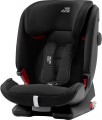ADAC test result
The results shown by the seat in crash tests according to the standards of ADAC — the General German Automobile Club, an authoritative European organization of motorists.
Car seats in such tests are evaluated in several categories, but in this point only one parameter is taken into account — the safety of the child, his/her protection in emergency situations. The results of such a test are indicated by the number of points; the fewer points in the end — the safer the product. It should be noted that the ADAC standards are much stricter than those by which the seat is evaluated during mandatory certification; tests are conducted with different directions of impacts (frontal and side), with dummies of different ages and so on. Therefore, the result of the ADAC test very reliably describes the real level of protection that the product provides in accidents.
According to this indicator, modern car seats can be divided into the following categories:
—
very good (< 1.5);
—
good (1.6 – 2.5);
—
satisfactory (2.6 – 3.5);
—
acceptable (3.6 – 4.5);
— unacceptable (more than 4.5).
The downside of a good value is usually a higher price; however, in an accident, that price may be a very small price to pay for the extra protection that can save your baby's life and health.
In c
...onclusion, it should be noted that ADAC test methods are constantly being improved and tests are conducted every year. Therefore, when choosing a seat and comparing it with its counterparts, you should also pay attention to the year of manufacture; as a rule, newer products with the same number of points give a higher actual level of protection than older ones.i-Size
The car seat meets the requirements of the European safety standard
i-Size (ECE R129). Within the framework of this standard, it is assumed that child car seats are classified according to the height and age of the child, and not by weight (as was previously the case). It is also mandatory to fasten the retaining device using the Isofix system (see “Isofix fastening”). In accordance with i-Size requirements, car seats must be installed rear-facing until the child is 15 months old or reaches a height of 105 cm. All i-Size certified car seats must pass a side impact test. Chairs and cars that meet the requirements of the standard are marked i-Size, which confirms their full compatibility.
Correct installation indicator
The presence in the design of the child restraint system of special
indicators of correct installation. They help ensure that the child car seat is installed correctly and follows all prescribed safety guidelines. Most often, such indicators are represented by special marks that change color or position when the car seat is installed correctly. Such indicators are placed on Isofix system locks, seat belts for fastening a child, etc. And some models for the youngest passengers have built-in levels or angle indicators that help set the seat in the correct position, facing the rear of the vehicle.
Additional side protection
The car seat has structural elements that further protect the child from side impacts. At least such elements include sidewalls for head protection made of impact-absorbing material such as polyurethane foam; torso protection may also be provided. If you are looking for a car seat with the maximum level of protection, you should choose from models with
additional side protection.

